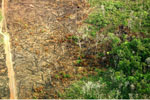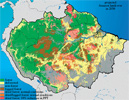
Fire in the Peruvian Amazon.
The risk of fire could increase across large parts of the Amazon rainforest due to increasing incident of drought, expansion of road networks, and rural outmigration, said a scientist speaking at the annual meeting of the Association for Tropical Biology and Conservation (ATBC) in Bonito, Brazil.
Maria Uriarte of Columbia University presented research on fire occurrence and frequency in the Peruvian Amazon using data from NASA’s MODIS system. She and her colleagues found that fire risk increases with drought and the proximity of roads, results consistent with studies elsewhere in the world. Surprisingly, the researchers also found a link between fire and rural outmigration. In other words, when small farmers abandon their plots and move to cities, the rate of burning goes up. Depopulation provides no relief for the Amazon.
Digger deeper into the counterintuitive result, Uriarte found a greater number of neighboring farms is associated with lower fire risk. While small farmers use fire in Peru, they also control it, often in cooperation with neighbors.
“Owner absenteeism leads to greater fire risk,” she said.
Given that all Amazon countries (excluding French Guiana) are expecting rural population decline in coming decades, the findings suggest another fire risk factor in the region, which is already experiencing more fires as a consequence of warmer, drier conditions related to a warmer tropical Atlantic, and expanding road networks, which attract industrial agricultural development and cattle ranches that often employ fire for land-clearing.
But Uriarte said there are potential solutions, including setting up an early warning system for vulnerable locations and populations, creating incentives for people to stay in rural areas, and encouraging ranchers and farmers not to employ fire in land use activities.
Fires in the Amazon have emerged as a global concern due to the large emissions they produce. Even small surface fires have an impact: other studies (including research presented at the ATBC conference by Paulo Brando of IPAM) have shown that Amazon rainforest can quickly transition to savanna after only two or three small surface fires — the type of fires most likely to escape from pasture and agricultural areas.
12/12/12 Update: This paper was formally published in PNAS in December 2012. CITATION: María Uriarte, Miquel Pinedo-Vasquez, Ruth S. DeFries, Katia Fernandes, Victor Gutierrez-Velez, Walter E. Baethgen, and Christine Padoch. Depopulation of rural landscapes exacerbates fire activity in the western Amazon
PNAS 2012 ; published ahead of print December 10, 2012, doi:10.1073/pnas.1215567110
Related articles
Repeated burning undercuts Amazon rainforest recovery
(09/26/2011) The Amazon rainforest can recover from logging, but has a far more difficult time returning after repeated burning, reports a new study in mongabay.com’s open-access journal Tropical Conservation Science. In areas where the Amazon had been turned to pasture and was subject to repeated burning, Visima trees become the dominant tree inhibiting the return of a biodiverse forest. The key to the sudden domination of Visima trees, according to the study, is that these species re-sprout readily following fires; a capacity most other Amazonian trees lack.
(08/31/2010) The number of fire hotspots has surged in the Bolivian and Brazilian parts of the Amazon, reveals data and imagery from NASA.
As Amazon deforestation rates fall, fires increase

(06/03/2010) While rates of forest loss in the Brazilian Amazon have been on the decline since 2004, the incidence of fire is increasing in the region, undermining some of the carbon emissions savings of reduced deforestation rates, report researchers writing in the journal Science. The paper argues that REDD, a global plan to reduce deforestation and forest degradation, must include measures to eliminate the use of fire from land management in the Amazon.
Smoke from Amazon fires reduces local rainfall
(08/14/2008) Smoke released by fires set to clear the Amazon rainforest inhibit the formation of clouds, thereby reducing rainfall, report researchers writing in the journal Science. The study provides clues on how aerosols from human activity influence cloud cover and ultimately affect climate.
Greenhouse gas emissions have already caused the Amazon to dry
(02/27/2008) Anthropogenic emissions of greenhouse gases have already caused the Amazon to dry, finds a new study published in Philosophical Transactions of the Royal Society B.
Small fires a big threat to Amazon rainforest biodiversity
(02/27/2008) Small fires have a big impact in the Amazon rainforest, report researchers writing in Philosophical Transactions of the Royal Society B. The findings suggest a dire future for Earth’s largest rainforest.
Half the Amazon rainforest will be lost within 20 years

(02/27/2008) More than half the Amazon rainforest will be damaged or destroyed within 20 years if deforestation, forest fires, and climate trends continue apace, warns a study published in Philosophical Transactions of the Royal Society B. Reviewing recent trends in economic, ecological and climatic processes in Amazonia, Daniel Nepstad and colleagues forecast that 55 percent of Amazon forests will be “cleared, logged, damaged by drought, or burned” in the next 20 years. The damage will release 15-26 billion tons of carbon into the atmosphere, adding to a feedback cycle that will worsen both warming and forest degradation in the region. While the projections are bleak, the authors are hopeful that emerging trends could reduce the likelihood of a near-term die-back. These include the growing concern in commodity markets on the environmental performance of ranchers and farmers; greater investment in fire control mechanisms among owners of fire-sensitive investments; emergence of a carbon market for forest-based offsets; and the establishment of protected areas in regions where development is fast-expanding.
Fire policy is key to reducing the impact of drought on the Amazon
(02/19/2008) Gaining control over the setting of fires for land-clearing in the Amazon is key to reducing deforestation and the impact of severe drought on the region’s forests, write researchers in a paper published in Philosophical Transactions of the Royal Society B.
55% of the Amazon may be lost by 2030
(01/23/2008) Cattle ranching, industrial soy farming, and logging are three of the leading drivers of deforestation in the Brazilian Amazon. As commodity prices continue to rise, driven by surging demand for biofuels and grain for meat production, the economic incentives for developing the Amazon increase. Already the largest exporter of beef and the second largest producer of soy – with the largest expanse of “undeveloped” but arable land of any country – Brazil is well on its way to rivaling the U.S. as the world’s agricultural superpower. The trend towards turning the Amazon into a giant breadbasket seems unstoppable. Nevertheless the decision at the U.N. climate talks in Bali to include “Reducing Emissions From Deforestation and Degradation” (REDD) in future climate treaty negotiations may preempt this fate, says Dr. Daniel Nepstad, a scientist at the Woods Hole Research Institute.
Subtle threats could ruin the Amazon rainforest

(11/07/2007) While the mention of Amazon destruction usually conjures up images of vast stretches of felled and burned rainforest trees, cattle ranches, and vast soybean farms, some of the biggest threats to the Amazon rainforest are barely perceptible from above. Selective logging — which opens up the forest canopy and allows winds and sunlight to dry leaf litter on the forest floor — and 6-inch high “surface” fires are turning parts of the Amazon into a tinderbox, putting the world’s largest rainforest at risk of ever-more severe forest fires. At the same time, market-driven hunting is impoverishing some areas of seed dispersers and predators, making it more difficult for forests to recover. Climate change — an its forecast impacts on the Amazon basin — further looms large over the horizon.